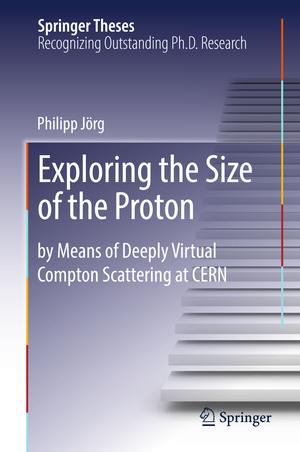Exploring the Size of the Proton: by Means of Deeply Virtual Compton Scattering at CERN: Springer Theses
Autor Philipp Jörgen Limba Engleză Hardback – 12 iul 2018
| Toate formatele și edițiile | Preț | Express |
|---|---|---|
| Paperback (1) | 637.78 lei 6-8 săpt. | |
| Springer International Publishing – 8 feb 2019 | 637.78 lei 6-8 săpt. | |
| Hardback (1) | 643.99 lei 6-8 săpt. | |
| Springer International Publishing – 12 iul 2018 | 643.99 lei 6-8 săpt. |
Din seria Springer Theses
- 5%
 Preț: 1154.07 lei
Preț: 1154.07 lei -
 Preț: 389.88 lei
Preț: 389.88 lei - 15%
 Preț: 646.94 lei
Preț: 646.94 lei - 18%
 Preț: 1220.45 lei
Preț: 1220.45 lei -
 Preț: 399.29 lei
Preț: 399.29 lei - 18%
 Preț: 997.88 lei
Preț: 997.88 lei - 18%
 Preț: 941.05 lei
Preț: 941.05 lei -
 Preț: 544.53 lei
Preț: 544.53 lei - 15%
 Preț: 643.16 lei
Preț: 643.16 lei - 15%
 Preț: 642.68 lei
Preț: 642.68 lei - 15%
 Preț: 639.25 lei
Preț: 639.25 lei - 20%
 Preț: 558.82 lei
Preț: 558.82 lei - 18%
 Preț: 943.43 lei
Preț: 943.43 lei - 18%
 Preț: 1116.26 lei
Preț: 1116.26 lei - 15%
 Preț: 640.06 lei
Preț: 640.06 lei - 15%
 Preț: 640.06 lei
Preț: 640.06 lei -
 Preț: 276.68 lei
Preț: 276.68 lei - 15%
 Preț: 636.45 lei
Preț: 636.45 lei - 18%
 Preț: 891.17 lei
Preț: 891.17 lei - 15%
 Preț: 640.88 lei
Preț: 640.88 lei -
 Preț: 389.70 lei
Preț: 389.70 lei - 20%
 Preț: 563.89 lei
Preț: 563.89 lei -
 Preț: 393.35 lei
Preț: 393.35 lei - 15%
 Preț: 637.93 lei
Preț: 637.93 lei - 15%
 Preț: 641.85 lei
Preț: 641.85 lei - 18%
 Preț: 1112.30 lei
Preț: 1112.30 lei - 20%
 Preț: 551.36 lei
Preț: 551.36 lei - 18%
 Preț: 1103.62 lei
Preț: 1103.62 lei - 18%
 Preț: 1109.92 lei
Preț: 1109.92 lei - 18%
 Preț: 1225.94 lei
Preț: 1225.94 lei - 18%
 Preț: 944.99 lei
Preț: 944.99 lei - 18%
 Preț: 944.19 lei
Preț: 944.19 lei - 15%
 Preț: 640.06 lei
Preț: 640.06 lei - 18%
 Preț: 1229.10 lei
Preț: 1229.10 lei - 15%
 Preț: 640.06 lei
Preț: 640.06 lei - 18%
 Preț: 1217.27 lei
Preț: 1217.27 lei - 15%
 Preț: 636.80 lei
Preț: 636.80 lei - 18%
 Preț: 1000.87 lei
Preț: 1000.87 lei - 15%
 Preț: 635.96 lei
Preț: 635.96 lei - 15%
 Preț: 640.88 lei
Preț: 640.88 lei -
 Preț: 387.20 lei
Preț: 387.20 lei - 18%
 Preț: 999.45 lei
Preț: 999.45 lei -
 Preț: 385.25 lei
Preț: 385.25 lei -
 Preț: 385.25 lei
Preț: 385.25 lei - 18%
 Preț: 1109.92 lei
Preț: 1109.92 lei - 18%
 Preț: 1110.72 lei
Preț: 1110.72 lei -
 Preț: 386.99 lei
Preț: 386.99 lei - 15%
 Preț: 637.13 lei
Preț: 637.13 lei - 20%
 Preț: 554.20 lei
Preț: 554.20 lei - 20%
 Preț: 555.57 lei
Preț: 555.57 lei
Preț: 643.99 lei
Preț vechi: 757.63 lei
-15% Nou
Puncte Express: 966
Preț estimativ în valută:
123.28€ • 126.86$ • 103.92£
123.28€ • 126.86$ • 103.92£
Carte tipărită la comandă
Livrare economică 01-15 martie
Preluare comenzi: 021 569.72.76
Specificații
ISBN-13: 9783319902890
ISBN-10: 331990289X
Pagini: 242
Ilustrații: XI, 231 p. 155 illus., 121 illus. in color.
Dimensiuni: 155 x 235 mm
Greutate: 0.52 kg
Ediția:1st ed. 2018
Editura: Springer International Publishing
Colecția Springer
Seria Springer Theses
Locul publicării:Cham, Switzerland
ISBN-10: 331990289X
Pagini: 242
Ilustrații: XI, 231 p. 155 illus., 121 illus. in color.
Dimensiuni: 155 x 235 mm
Greutate: 0.52 kg
Ediția:1st ed. 2018
Editura: Springer International Publishing
Colecția Springer
Seria Springer Theses
Locul publicării:Cham, Switzerland
Cuprins
Introduction.- Theory.- The COMPASS-II Experiment.- The Kinematically Constrained Fit.- The 2012 DVCS Data.- Event Selection and Simulations.- The Cross Section and its t-Dependence.- Summary.
Notă biografică
Jörg Philipp completed his diploma in physics in 2013 and his PhD in subatomic physics in 2017 at the Albert-Ludwigs-Universität Freiburg in Germany. In both cases he was deeply involved in the COMPASS II measurement program for exclusive reactions, which aims to improve our understanding of the nucleon by experimentally constraining generalized parton distribution functions. Since 2017 he has worked as a PostDoc in subatomic physics and continues his research related to the measurement of exclusive and semi-inclusive reactions within the COMPASS collaboration. Since 2018 he has been affiliated to the Rheinische Friedrich-Wilhelms-Universität Bonn in Germany.
Textul de pe ultima copertă
This book is a rare jewel, describing fundamental research in a highly dynamic field of subatomic physics. It presents an overview of cross section measurements of deeply virtual Compton scattering. Understanding the structure of the proton is one of the most important challenges that physics faces today. A typical tool for experimentally accessing the internal structure of the proton is lepton–nucleon scattering. In particular, deeply virtual Compton scattering at large photon virtuality and small four-momentum transfer to the proton provides a tool for deriving a three-dimensional tomographic image of the proton. Using clear language, this book presents the highly complex procedure used to derive the momentum-dissected transverse size of the proton from a pioneering measurement taken at CERN. It describes in detail the foundations of the measurement and the data analysis, and includes exhaustive studies of potential systematic uncertainties, which could bias the result.
Caracteristici
Nominated as an outstanding PhD thesis by the Albert-Ludwigs-University, Freiburg, Germany Presents an overview of cross section measurements of deeply virtual Compton scattering Provides detailed (numerous comparisons of experimental distributions with simulations) step-by-step illustrations of how an absolute cross section can be extracted in particle physics
